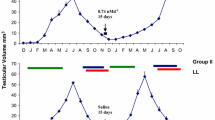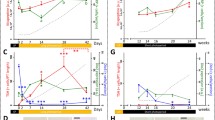Summary
Photoperiodic induction occurs in Japanese quail after exposure to a single long day and this leads to a wave of pituitary LH secretion which lasts for up to 10 days. Pharmacological doses of thyroid hormones mimic this photoperiodic response if given to quail on short days, the magnitude and duration of the rise in LH and FSH output being dose-dependent. Thyroxine (T4) is some 7 times more potent than tri-iodothyronine (T3). There is no effect of T4 on LH secretion in quail already on long days although such birds can increase LH output markedly if treated with Gn-RH. Testosterone prevents the initial rise in LH secretion following T4 but does not block the long-term effect, suggesting that T4 acts high in the photoneuroendocrine chain to mimic long days. The first rise in LH secretion following T4 injection takes place about 24 h after the injection and the time-scale of secretion is quite similar to that seen when quail are exposed to a long day. T4 elicits a rise in LH secretion even if the quail are maintained in darkness. However, T4 does not act simply as ‘light’ for if it is given at the exact time when birds are in a photoinducible state (i.e. 12–16 h after dawn) the rise in LH secretion still occurs 24 h later.
Similar content being viewed by others
Abbreviations
- FSH :
-
follicle stimulating hormone
- Gn-RH :
-
gonadotropin releasing hormone
- LH :
-
luteinizing hormone
- T 4 :
-
thyroxine
- T 3 :
-
tri-iodothyronine
References
Chakraborty S (1985) Investigations of the roles of prolactin and thyroid hormones in the phenomenon of photorefractoriness in European starlings and in two species of hamsters. PhD thesis, University of Bristol
Chandola A, Bhatt D (1982) Tri-iodothyronine fails to mimic gonadoinhibitory action of thyroxine in Spotted Munia: effects of injections at different times of the day. Gen Comp Endocrinol 48:499–503
Davies DT, Bicknell RJ (1976) The effect of testosterone on the responsiveness of the quail's pituitary to luteinizing hormone releasing hormone (LH-RH) during photoperiodically induced testicular growth. Gen Comp Endocrinol 30:487–499
Dawson A, Goldsmith AR, Nicholls TJ (1985) Thyroidectomy results in termination of photorefractoriness in starlings (Sturnus vulgaris) kept in long daylengths. J Repord Fertil 74:527–533
Earnest DJ, Turek FW (1985) Neurochemical basis for the photic control of circadian rhythms and seasonal reproductive cycles: role of acetylcholine. Proc Nat Acad Sci 82:4277–4281
Follett BK (1976) Plasma follicle-stimulating hormone during photoperiodically induced sexual maturation in the male Japanese quail. J Endocrinol 69:117–126
Follett BK, Nicholls TJ (1985) Influences of thyroidectomy and thyroxine replacement on photoperiodically controlled reproduction in quail. J Endocrinol 107:211–221
Follett BK, Scanes CG, Cunningham FJ (1972) A radioimmunoassay for avian luteinizing hormone. J Endocrinol 52:359–378
Follett BK, Davies DT, Gledhill B (1977) Photoperiodic control of reproduction in Japanese quail: changes in gonadotrophin secretion on the first day of induction and their pjarmacological blockade. J Endocrinol 74:449–460
Follett BK, Nicholls TJ, Mayes CR (1988) Thyroxine can mimic photoperiodically induced gonadal growth in Japanese quail. J Comp Physiol B 157:829–835
Foster RG, Follett BK (1985) The involvement of a rhodopsin-like photopigment in the photoperiodic response of the Japanese quail. J Comp Physiol A 157:519–528
Goldsmith AR, Nicholls TJ (1984a) Thyroxine induces photorefractoriness and stimulates prolactin secretion in European starlings (Sturnus vulgaris). J Endocrinol 101:R1-R3
Goldsmith AR, Nicholls TJ (1984b) Thyroidectomy prevents the development of photorefractoriness and the associated rise in plasma prolactin in starlings. Gen Comp Endocrinol 54:256–263
Nicholls TJ, Follett BK, Robinson JE (1983a) A photoperiodic response in gonadectomized Japanese quail exposed to a single long day. J Endocrinol 97:121–126
Nicholls TJ, Urbanski HF, Follett BK, Simpson SM (1983b) An apparent neural basis for ‘carry-over’ of gonadotrophin secretion in quail. S.S.F. Annual Conference, Manchester, July 1983, abstract no 113
Parés Herbuté N, Astier H (1985) The relative potencies of L-T4 and L-T3 on the pituitary-thyroid axis in the Japanese quail. Gen Comp Endocrinol 60:298–305
Saiovici MS, Nicholls TJ, Follett BK (1987) Rapid photoperiodic responses in Japanese quail: is daylength measurement based upon a circadian system? J Biol Rhythms (in press)
Vaugien L (1954) Influence de l'obscuration temporaire sur la durée de la phase réfractaire du cycle sexuel du moineau domestique. Bull Biol Fr Belg 88:294–304
Wieselthier AS, van Tienhoven A (1972) The effect of thyroidectomy on testicular size and on the photorefractory period in the starling (Sturnus vulgaris). J Exp Zool 179:331–338
Author information
Authors and Affiliations
Rights and permissions
About this article
Cite this article
Follett, B.K., Nicholls, T.J. Acute effect of thyroid hormones in mimicking photoperiodically induced release of gonadotropins in Japanese quail. J Comp Physiol B 157, 837–843 (1988). https://doi.org/10.1007/BF00691016
Accepted:
Issue Date:
DOI: https://doi.org/10.1007/BF00691016




